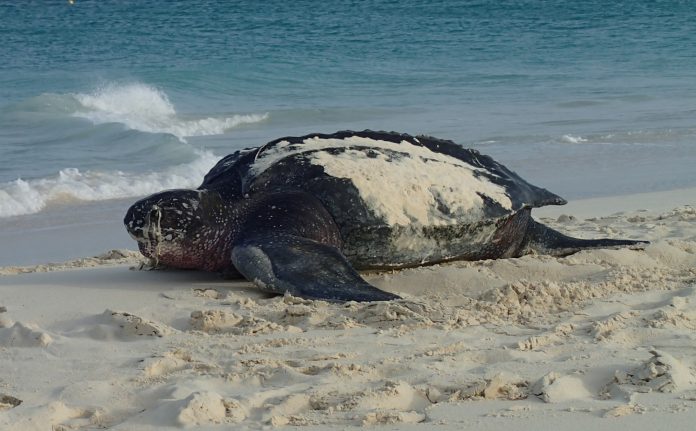The Leatherback Sea Turtles nesting on Aruba don’t live in the Caribbean, but in the Northern part of the Atlantic Ocean, off the coast of Nova Scotia, Canada. But they are born on Aruba’s beaches. After 20 – 30 years they reach maturity and then return to their natal beach in order to nest during the turtle nesting season.
It is very impressive to see a huge sea turtle coming ashore, enjoy the sight, but make sure that the turtle does not see you! Stay out of her sight at a distance of at least 10 meters. All species of sea turtles are endangered and need our protection. Normally sea turtle females will nest at night.
What you can do to protect sea turtles:
- Lights out for sea turtles. Nighttime activities and artificial lighting may deter adult females from nesting. So PLEASE keep all lights off, including flashlights, flash photography and video equipment. “Sea turtles dig the dark”
- Ask your hotel manager to turn off or minimize the lights that are visible on the beach in front of the resort. Close the curtains of your room at night to prevent light shining on the beach.
- Do not drive on beaches. Not all of the turtle nests on all the beaches around Aruba are marked. Vehicles (4×4, quads) can crush the eggs and will compact the sand. Driving on a beach is not good for the condition of the sand (and also for our own condition it is better to walk!)
- Do not litter. Do not leave any plastic cups, straws or bags on the beach. The wind will blow it into the sea. A floating plastic bag is easily mistaken for a jellyfish, the Leatherback Sea Turtle’s favorite food.
- Remove obstacles from the beach. Obstacles as beach furniture or recreational equipment may cause nesting females to abort their nesting attempt or may even trap them. So don’t leave any beach chairs at night unattended close to the sea, but make a stack as far as possible away from the water.
- Do not disturb a nesting sea turtle. Do not attempt to touch the turtle but stay at a respectful distance (at least 10 meters). Do allow the turtle to complete the full nesting process (about two hours) and don’t be in her way when she returns to the sea.
- Do call Turtugaruba (24 hour Turtle Hotline: (297) 5929393).
- If you witness a sea turtle, or if you see turtle crawl marks, during a late evening or early morning stroll on the beach please do call Turtugaruba or notify the front desk of your hotel. Thanks!
Follow Turtugaruba at www.facebook.com/Turtugaruba




















